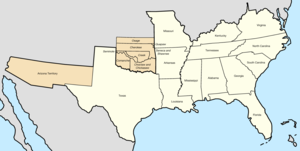
Back Virginie durant la guerre de Sécession French Virginia nella guerra di secessione americana Italian Виргиния в Гражданской войне Russian
| Virginia | |
|---|---|
| Nickname(s): "Virginny" | |
 Map of the Confederate States | |
| Capital | Richmond |
| Largest city | Richmond |
| Admitted to the Confederacy | May 7, 1861 (8th) |
| Population |
|
| Forces supplied | |
| Governor | John Letcher William Smith Francis Pierpont |
| Senators | William Ballard Preston Allen T. Caperton Robert M. T. Hunter Waitman Willey John Carlile Lemuel Bowden |
| Representatives | List |
| Restored to the Union | January 26, 1870 |
| History of Virginia |
|---|
|
|
 |
|
Confederate States in the American Civil War |
|---|
|
|
| Dual governments |
| Territory |
|
Allied tribes in Indian Territory |

The American state of Virginia became a prominent part of the Confederacy when it joined during the American Civil War. As a Southern slave-holding state, Virginia held the state convention to deal with the secession crisis and voted against secession on April 4, 1861. Opinion shifted after the Battle of Fort Sumter on April 12, and April 15, when U.S. President Abraham Lincoln called for troops from all states still in the Union to put down the rebellion. For all practical purposes, Virginia joined the Confederacy on April 17, though secession was not officially ratified until May 23. A Unionist government was established in Wheeling and the new state of West Virginia was created by an act of Congress from 50 counties of western Virginia, making it the only state to lose territory as a consequence of the war. Unionism was indeed strong also in other parts of the State, and during the war the Restored Government of Virginia was created as rival to the Confederate Government of Virginia, making it one of the states to have 2 governments during the Civil War.
In May, it was decided to move the Confederate capital from Montgomery, Alabama, to Richmond, Virginia, in large part because, regardless of the Virginian capital's political status, its defense was deemed vital to the Confederacy's survival. On May 24, 1861, the U.S. Army moved into northern Virginia and captured Alexandria without a fight. Most of the battles in the Eastern Theater of the American Civil War took place in Virginia because the Confederacy had to defend its national capital at Richmond, and public opinion in the North demanded that the Union move "On to Richmond!" The successes of Robert E. Lee in defending Richmond are a central theme of the military history of the war. The White House of the Confederacy, located a few blocks north of the State Capitol, became home to the family of Confederate leader, former Mississippi Senator Jefferson Davis.
- ^ Sheehan-Dean, Aaron. [1]. Encyclopedia Virginia. Retrieved January 29, 2021.
- ^ The United States Colored Troops. Encyclopedia Virginia. Retrieved January 29, 2021.

